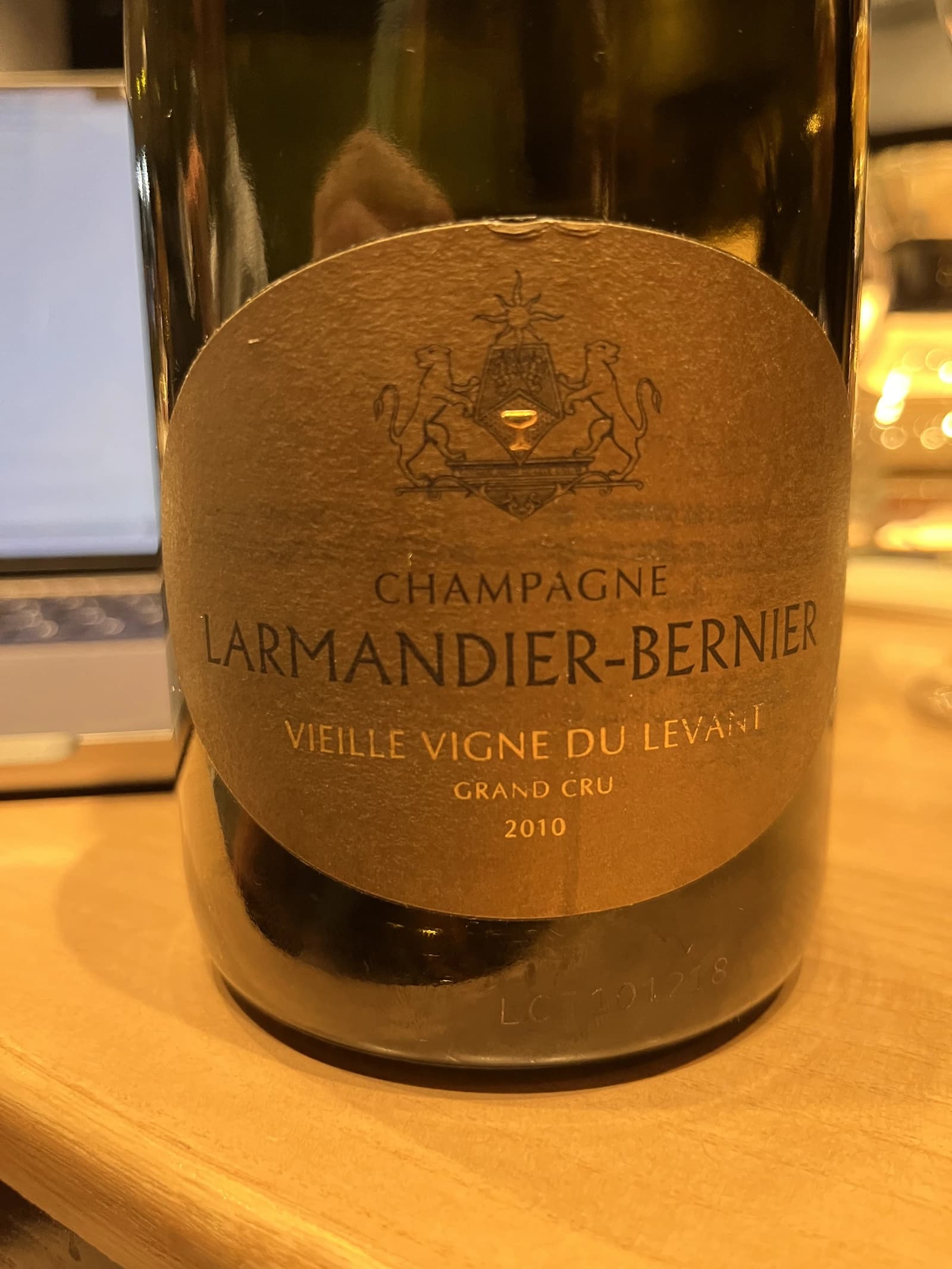Larmandier-Bernier Vieille Vigne du Levant Grand Cru 2010
- Region
- France » Champagne » Champagne AOC » Côte des Blancs » Cramant
- Type
- white traditional sparkling, extra brut
- Producer
- Vintage
- 2010
- Disgorged
- N/A
- On lees
- >108 months
- Grapes
- Chardonnay
- Alcohol
- 12.5
- Sugar
- 2
- Volume
- 750 mL
- Cellar
- not available
- Find at

The old vines of the Levant face south-east and benefit from an exceptional terroir. They are between 60 and more than 85 years old. Their roots go down deep, and the diversity of the old vine stocks contributes to the complexity of the wine. As is the case for the estate’s entire vineyard, they are cultivated naturally so as to obtain perfect ripeness.
Since the creation of this cuvée in 1988, it had been necessary to explain the difference between “Cramant” and “crémant”. In order to avoid this confusion, the name has changed: Vieille Vigne de Cramant has become Vieille Vigne du Levant!
Indeed, this cuvée’s place name is “Bourron du Levant”. The “Levant” signifies the East and the vineyard parcel benefits from the sun’s first rays in the morning. In Cramant, the vines of the Levant are very different from those growing on the other side of the slope and looking West. The side facing East in Cramant gives birth to particularly rich and powerful grapes; it’s a magical place.
The grapes are pressed gently, the juices are clarified very slightly and then go directly into wood. The natural alcoholic fermentation (indigenous yeasts) and the malolactic fermentation begin spontaneously in the Stockinger casks and vats. The wines are matured on the lees during their first year, with no filtering or fining being carried out.
The tirage takes place in July. There’s no blending with other years – this is a vintage Champagne – and no blending with other terroirs – this is a single-parcel Champagne. The bottles are taken down into the coolness of the cellars and stacked on lattes, the second fermentation takes place and the maturation continues slowly for 9 more years.
Each bottle is disgorged by hand 1 year before being marketed. The dosage is very discreet so as to appreciate better this well-balanced and extremely long cuvée (2 g/l).
Ratings
This wine presents a fascinating bouquet, combining mushrooms and onion soup with the minerality of chalk. These are complemented by the sweetness of baked apples and honey, with intriguing notes of iodine and sea breeze adding depth. Its intense, oily texture is masterfully balanced by a backbone of nice acidity and distinct minerality. The finish is long and evolving, featuring flavours of lemon and the damp, earthy character of a wet cellar. Overall, it's a complex wine that successfully marries a diverse range of flavours.
About Producer
Larmandier-Bernier is one of those domaines that doesn't scream for attention - but if you pay attention, it's hard to look away. Pierre Larmandier took over the family estate in 1988 and has quietly built one of the most respected grower operations in Champagne, especially in the Côte des Blancs. His path wasn't loud or trendy - just persistent, thoughtful, and increasingly precise.
The estate itself has roots going back to the French Revolution, though it formally came together in 1971 through the marriage of Philippe Larmandier and Elisabeth Bernier. Today, it's Pierre and Sophie Larmandier, along with their son Arthur, who run the show - working nearly 18 hectares spread across some of the most iconic chalk soils in Champagne: Cramant, Chouilly, Oger, Avize (all Grand Cru), and Vertus (Premier Cru). Chardonnay dominates, as expected, but there are also small parcels of Pinot Noir and Pinot Gris.
By 1999, the estate had fully converted to biodynamic farming. Yields are kept low, and many of the vines are now approaching or well past 50 years of age. Nothing here is rushed, nothing feels accidental.
In the cellar, the approach is about letting the vineyards speak. Each cru is vinified separately, with native yeasts and minimal intervention. Fermentation happens in large foudres and Burgundian barrels, depending on the parcel and year. Malolactic fermentation is not feared; blending decisions are made calmly in the summer following harvest. And dosage - when it appears at all - is minimal and always earned in the vineyard.
The lineup is tight and expressive: Latitude, Longitude, Terre de Vertus, Les Chemins d'Avize, Vieille Vigne du Levant, and the Rosé de Saignée. The wines are brisk and mineral, yet never hollow. They carry texture, but not weight. They age beautifully but are never closed off.